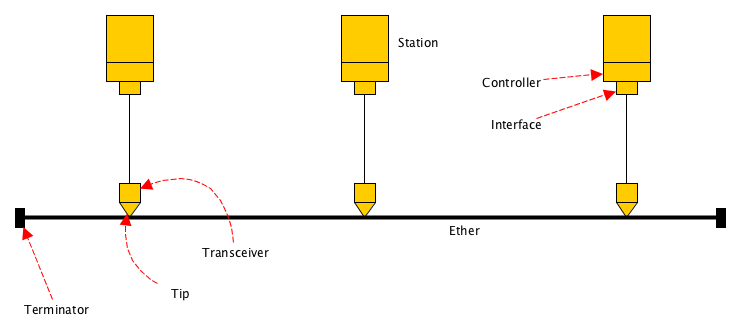Ethernet
Unit Goals
Where to Learn About Ethernet
These notes will not give you very much information. Much more data can be found at Wikipedia, of course, but also at the very comprehensive Ethermanage pages.
What Ethernet is
Ethernet:
- Is a link-layer technology, developed at Xerox PARC in the 1970s and became commercially available in 1980 in a 10Mbps version.
- Was first officially standardized in 1983.
- Is the #1 wired LAN technology in the world today
- Was originally done as a ~3MBps shared coaxial cable technology; now runs on twisted pair and fiber optic as well, with some speeds up to 400Gps (!)
It is defined in a number of official IEEE Standards (Credit, Much more complete list):
| Standard | Year | What it Covered |
|---|---|---|
| 802.3 | ? | 10BASE5, first commercially available, 10Mbps, 500m max, “thick Ethernet” (named for the thick coax cable), DEPRECATED |
| 802.3a | 1985 | 10BASE2, “thin Ethernet,” cheapernet, 185m max |
| 802.3b | 1985 | 10BROAD36, obsolete |
| 802.3d | 1987 | Fiber-optic inter repeater link |
| 802.3e | 1987 | 1BASE5 StarLAN (first twisted pair version) |
| 802.3i | 1990 | 10BASE-T, Ethernet over twisted pair |
| 802.3j | 1993 | 10BASE-F, Ethernet over fiber optic |
| 802.3u | 1995 | 100BASE-TX, 100BASE-T4, 100BASE-FX “Fast Ethernet,” 100Mbps, autonegotiation |
| 802.3x | 1997 | Full duplex, flow control |
| 802.3y | 1998 | 100BASE-T2 (low-quality twisted pair) |
| 802.3z | 1998 | 1000BASE-X, Gigabit Ethernet over fiber optic |
| 802.3ab | 1999 | 1000BASE-T, Gigabit Ethernet over twisted pair |
| 802.3ac | 1998 | Frame size extension to 1522 bytes with Q-tag |
| 802.3ad | 2000 | Parallel links (link aggregation) |
| 802.3ae | 2002 | 10GBASE-{SR,LR,ER,SW,LW,EW} 10 Gigabit Ethernet |
| 802.3as | 2006 | Frame expansion |
| 802.3az | 2010 | Energy efficient Ethernet |
| 802.3em | 2015 | 100G/40G Ethernet for optical fiber |
| 802.3bq | 2016 | 25G/40GBASE-T for 4-pair balanced twisted-pair cabling with 2 connectors over 30 m distances |
| 802.3bz | 2016 | 2.5GBASE-T and 5GBASE-T, 2.5 Gigabit and 5 Gigabit Ethernet over Cat-5/Cat-6 twisted pair |
This list is incomplete, as new standards are being written as the technology evolves.
What do those descriptors mean?
- First part: megabits per second, unless qualified with a G
- 10: 10Mbps
- 100: 100Mbps
- 1000: 1Gps (= 1000Mbps)
- 4G: 4Gps
- Second part
- BASE: Baseband
- BROAD: Broadband
- Third part
- 5: thick coaxial cable up to 500m
- 2: thin coaxial cable
- T: twisted pair
- T4: four twisted pairs
- F: fiber
- SR, LR, ER: short range, long range, extended range
- (There seem to be dozens more....)
The Original Design
History is fun! The original design built a LAN with a single, shared coax cable.

Each station sent frames over the ether to the other stations. Because they all shared the same medium, some kind of Media Access Control (MAC) had to be developed.
An early form of media access control was called Carrier Sense Multi Access with Collision Detection (CSMA/CD). The algorithm was something like:
- A station waits for the medium to be idle
- A station starts transmitting
- If a collision is detected, the station uses a truncated binary exponential backoff: it waits a random duration in the range 0..d before retrying. If another collision, it waits a random time in 0..2d, then in 0..4d.
By the way, modern Ethernet systems are collision-free.
Ethernet Addressing
Every station has a globally unique 48-bit address, called its physical address, or MAC address, or Hardware addresss.
We write these addresses as six colon separated octets in hexidecimal.
Example: 07:2E:95:C2:BB:1F.
By convention, FF:FF:FF:FF:FF:FF is the broadcast address.
The Ethernet Frame
Best to just read the Wikipedia article for this.
Summary
We’ve covered:
- What Ethernet is
- The original Ethernet design
- The different standards
- CSMA/CD
- Hardware
- Addressing
- Format of an Ethernet frame
- Where to find more information